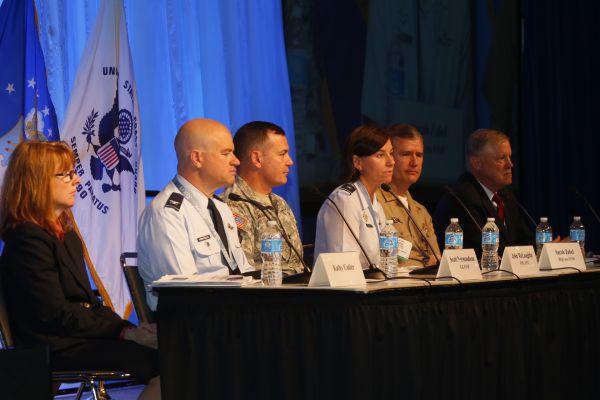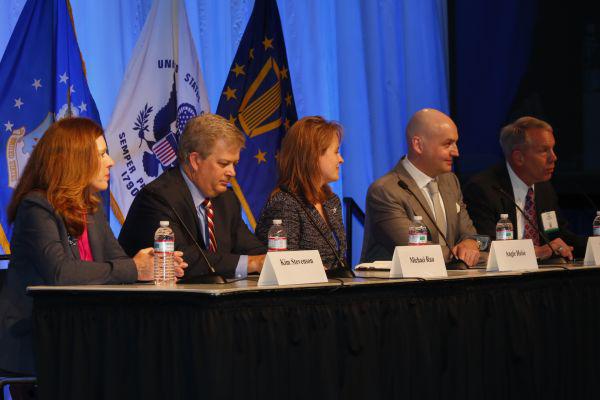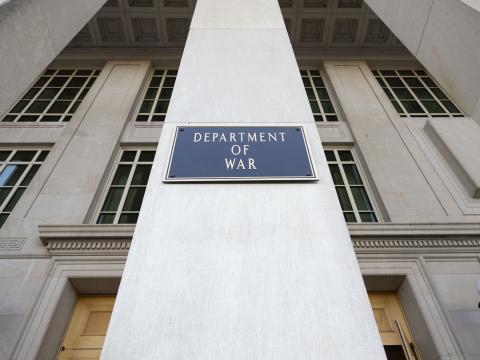Many Choices, Few Clear Paths to Information Environments
JIE Mission Partner Symposium 2014
The SIGNAL Magazine Online Show Daily, Day 2
Quote of the Day:
“Why make every hacker an enemy? There are many people who would help find breaches on our side—if only we would just treat them better.”
—Lars Buttler, managing director, Madison Sandhill Global LLC
No clear technology or architecture has emerged to define the future Joint Information Environment (JIE). While the military has a goal in mind, it also recognizes that information technologies and capabilities are evolving faster than planners can predict. The commercial sector itself, which could serve as a fount of ideas for defense networking, is structuring its strategies to accommodate unforeseen changes. Different parts of the defense and intelligence communities have their own nonnegotiable requirements for JIE participation. Meanwhile, hovering above all potential approaches to achieving an effective information environment is cybersecurity.
Different challenges and potential solutions were the focus of day 2 at AFCEA’s three-day JIE Mission Partner Symposium being held in Baltimore May 12-14. The day began with a panel featuring military officers offering views from different command perspectives, and it ended with a panel of private sector technology officials discussing the challenges and solutions in their companies’ activities. While some discussions were JIE-specific, many of the points raised applied to information sharing and networking as a whole.
The dominance of information in military operations was brought home by Brig. Gen. Sarah Zabel, USAF, director, command, control, communications and cyber, J-6, U.S. Transportation Command (TRANSCOM). She told the audience that the command moves information more than it does any physical commodity. Also, more than 90 percent of the command’s order fulfillment is done through commercial partners.
“We do very little of moving people or stuff—we largely move information,” she said. “We have to look at our information being in a low-assurance environment.”
TRANSCOM has moved its command and control system inside a security boundary. These secure systems are “the JIE for TRANSCOM,” she allowed, and they will go to the greater JIE. “Security will be the top consideration,” Gen. Zabel emphasized. “We’re keeping a sharp eye on that, looking forward to a productive future in which we and JIE converge.”
The Defense Logistics Agency (DLA) has shifted its focus from geography to information, said Kathy Cutler, director of information operations (J-6) and chief information officer at the DLA. By moving from a geographic focus to an information environment, the agency has opened the door to equipping its disposition yard personnel with advanced mobile technologies such as tablets. This will enable broader functions with personnel having more access to important information, she noted.
The U.S. Special Operations Command (SOCOM) is one of those defense organizations that has many unique information technology requirements. Col. John E. McLaughlin, USA, C-4 operations chief, SOCOM, explained that the command must provide networking for a theater force that can range from one person up through thousands of people. It also faces diverse mission needs that can require large communications pipes. Among the high-bandwidth services its forces require are full-motion videos and a Web portal presence, for example. Forces must be able to share information, he emphasized.
Another group with its own information technology concerns is the intelligence community. Its Intelligence Community Information Technology Enterprise (ICITE) serves as its own JIE, but it will link with the JIE through the Defense Intelligence Information Enterprise (DI2E). Al Tarasiuk, chief information officer, Office of the Director of National Intelligence, described both the formation of ICITE and how DI2E will be the bridge between the two environments. The intelligence community is working with many defense partners, particularly the Defense Information Systems Agency (DISA), to make this bridge function effectively for both sides.
One of the core elements facing the intelligence community is security, and that came in for its own focus in panel discussions. Rear Adm. Hank Bond, USN, J-6, U.S. Northern Command (NORTHCOM) and deputy J-3 for cyberspace operations at NORAD, declared that cybersecurity for the homeland begins at home.
“Where does homeland security end and homeland defense begin?” he asked. “The contested environment is in the dot com; it’s in your computer at home.”
Adm. Bond offered that actions by an adversary in cyberspace would not be exclusively decisive. However, NORTHCOM needs to know when the homeland is being threatened. He called for the ability to sense what is happening in cyberspace “beyond our foxhole.” Having a defensible architecture would allow the command to sense outward what is happening, he said.
He also said the National Guard should have a greater role in domestic cybersecurity. “Our way forward in cyberspace is to properly develop the force structure around the Guard,” the admiral declared. “The commercial space is the contested space.”
Col. Scott W. Normandeau, USAF, director, J-6/CIO, National Guard Bureau, noted that the multitude of threats will require closer partnerships. The Guard is looking forward to working with its Defense Department partners on the JIE and shared mission needs.
The private sector weighed in with its own approaches to cybersecurity. “Cyber is kind of the dark side of the moon in terms of everything connected,” said Lars Buttler, managing director, Madison Sandhill Global LLC. “Connect everything, and a breach affects everything and spreads quickly.”
Kim Stevenson, corporate vice president and chief information officer, Intel Corporation, described how her company is addressing security by saying, “It’s about enabling people to consume things in a safe and secure environment.
“Our entire business is intellectual property,” she pointed out. “We protect data instead of technology.
As an example, Stevenson related that the company has a bring-your-own-device (BYOD) policy that has security as its cornerstone. “We allow BYOD, but we control that device. If you leave Intel, we swipe that device clean. If you lose it, we remote swipe it.”
Buttler offered one of the more unusual suggestions for achieving cybersecurity in the defense community: hire hackers.
“Why make every hacker an enemy?” he asked. “There are many people who would help find breaches on our side—if only we would just treat them better.”
Buttler added that hackers might appreciate a different type of reward from the military. “The reward does not have to be monetary,” he offered. “It could be standing in the community.”
Coming up on the final day of JIE 2014: A panel discussion focusing on DISA and the road ahead, and a keynote luncheon address by Lt. Gen. Mark Bowman, USA, J-6, The Joint Staff.







Comments